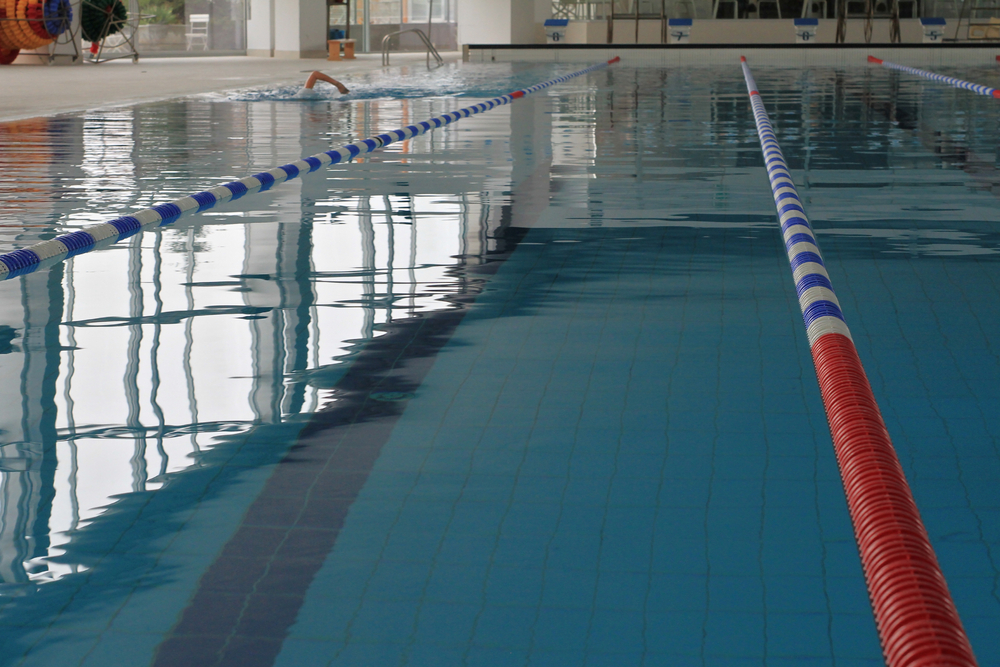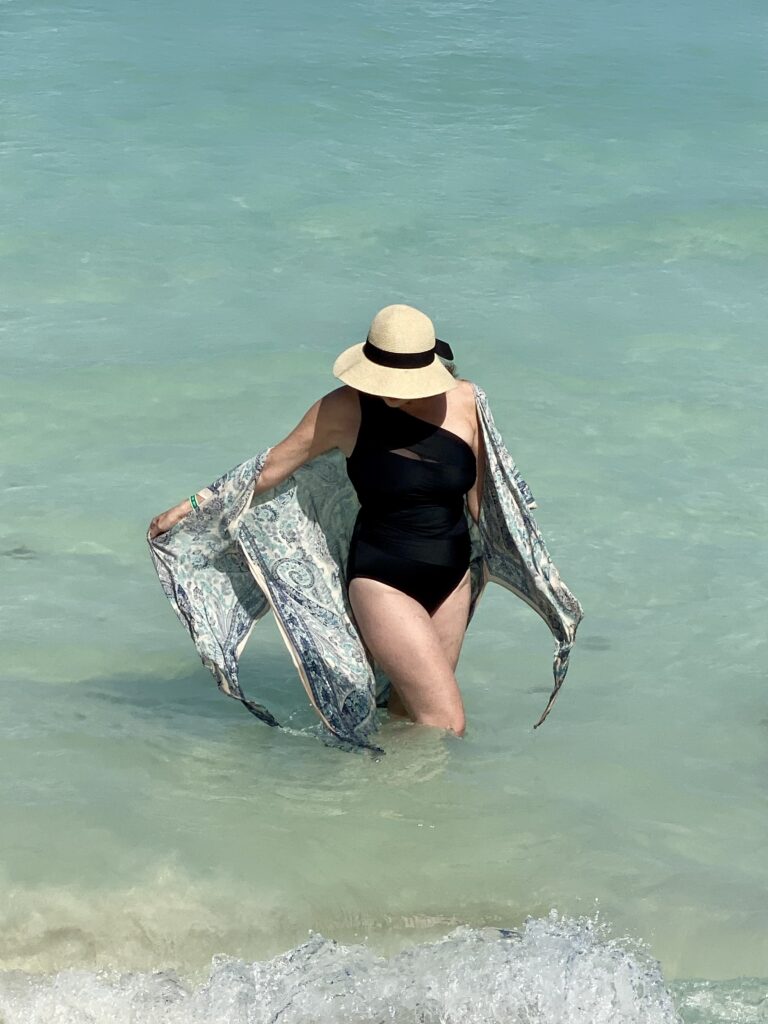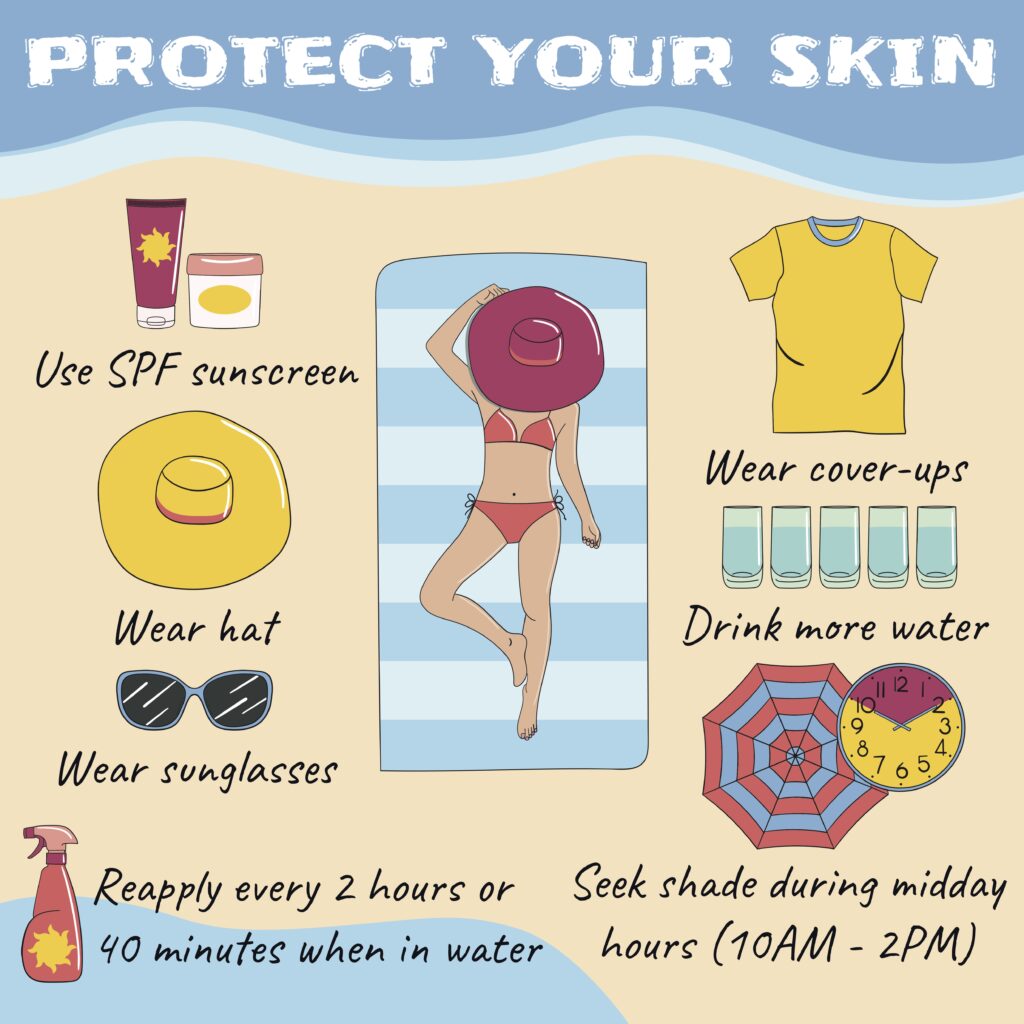What's On This Page?
ToggleDo you swim in chlorinated pools, or do you prefer the salt water of the beach?
Here in Colorado, they open our community pool in late May and it stays open for swimming until September. I only go swimming there a couple of times during the season, however, I use my hot tub pretty routinely, especially in the winter when it’s cold or snowy.
Exposure to the chlorinated hot tub makes my skin very dry, and sometimes itchy. It also makes my fingers and toes “pruney” if I stay in it for more than 20 minutes. Has this happened to you?
It’s not your body staging a revolt against the chlorine, it’s actually an evolutionary trait thought to enhance our grip underwater and a sign of mild dehydration.
Today, I thought it would be fun to take a look into the effects of a chlorinated pool, and compare that to beach water since I went swimming in Cancun recently but had to get out almost immediately! I’ll tell you that story shortly.
Swimming, a pastime loved by millions, is more than just a recreational activity. It’s a fitness regimen, a therapeutic routine, and an avenue for pure enjoyment. In 2019 alone, nearly 27 million Americans took part in swimming activities, with this figure rising annually. But whether you’re a pool enthusiast or a beach aficionado, understanding the impact of your aquatic environment on your skin is paramount.

The Reality of Chlorinated Pools
Most chlorinated pools rely on chlorine as a robust disinfectant, keeping the water free from harmful bacteria and providing us with a relatively germ-free swimming experience.
However, this comes with a price as your skin may not react as favorably especially if you stay in the water for long periods of time (like kids do!).
Chlorine very quickly strips away the natural oils that protect the skin, leading to dryness, dehydration, and sometimes an itchy, flaky texture.
For individuals with pre-existing conditions like eczema or psoriasis, chlorinated pools can cause major flare-ups, resulting in inflammation, redness, and irritation. It’s because it’s taking away the ‘probiotics’ that live in your skin.
Maybe you thought probiotics were limited to inside your gut? It’s not the case, there is actually a thriving microbiome on your skin! People with skin conditions like dermatitis, eczema, acne, a poor complexion and rosacea are known to have a disrupted skin microbiome – that’s exactly why I put a special patented probiotic blend in DermaScript capsules!
Anyway, the disruption of your skin’s microbiome balance by anything will hasten the aging process by breaking down elastin and collagen, leading to fine lines and wrinkles.
However, the story doesn’t end with just chlorine-induced problems. Even with chlorine present, inadequately maintained pools or hot tubs may harbor harmful organisms.
For instance, the bacterium Pseudomonas aeruginosa is a common contaminant in improperly chlorinated hot tubs. It can cause a condition known as pseudomonas dermatitis or “hot tub rash” characterized by itchy, red bumps, and sometimes blisters.
This bacterium can also infect hair follicles, leading to folliculitis. In addition to bacterial issues, chlorinated pools can become breeding grounds for the fungi causing athlete’s foot and the viruses behind plantar warts.
Swimming in chlorinated pools, or soaking in a chlorinated hot tub will deplete levels of iodine in your thyroid and contribute to symptoms of hypothyroidism. A lot of people don’t realize that this antioxidant mineral (iodine) is an absolutely critical nutrient for thyroid health because it is a component of two thyroid hormones, thyroxine (T4) and triiodothyronine (T3). Your thyroid gland uses iodine to make these hormones.
So if you’re swimming in chlorinated pools a lot, or getting into the hot tub a lot, then you may be depleting your iodine levels. In areas where iodine intake is insufficient (or you’ve depleted your own stash!) the thyroid gland can’t produce enough thyroid hormone. So it leads to hypothyroidism which then causes unexplained fatigue, weight gain, and cold intolerance.
If you are worried about this issue, take a look at my supplement for IODINE. It’s a hypoallergenic capsule containing both isomers (iodine AND iodide) which is how your thyroid gland and reproductive organs use it.
For anyone trying to figure out what I am saying here, it’s essentially this: Chlorinated pools or anything with chlorine is a drug mugger of natural iodine. If you enjoy swimming then you may be deficient in iodine and the iodine should be replenished before symptoms set in: Dry skin, thinning hair, fatigue, cold intolerance and brain fog.
Lastly, swimming in contaminated water can lead to conjunctivitis, an eye infection that, while not a skin issue, certainly contributes to your discomfort post-swimming! Maybe use goggles while swimming underwater. So it begs the question, is your skin better off swimming in the ocean?
The Salty Tale of Ocean Water
On the other end of the spectrum, the vast, open waters of the ocean provide a different swimming experience.
Historically, saltwater has been used therapeutically for its healing properties. Hippocrates, considered the father of modern medicine, was one of the first people to promote the therapeutic use of saltwater suggesting his patients bathe in seawater. It’s called “thalassotherapy” and “thalass” means ocean in Greek.
Salt water spas still abound, and in a controlled setting like this it is just fine. But I’m talking about people who like to swim in salt water at the beach, and for hours… perhaps with a Margarita. Just like chlorinated pools, saltwater at the beach has its own share of drawbacks. There are also saltwater pools, and saltwater hot tubs, it’s not just the beach.
Anyway, swimming in high salt concentrations can cause dehydration and dryness, by drawing out moisture from your skin exacerbating conditions like eczema and psoriasis. Just like chlorine, the worsening of these conditions is due to the disruption of the skin’s barrier function. That is after all the skin’s #1 job – to provide a barrier between the environment and the inside of you!
Additionally, in very salty water the salt crystals will act as mild physical irritants, leading to inflammation and discomfort if you’re in there too long.
Fun Fact: Did you know that the Dead Sea, one of the saltiest bodies of water on Earth, can turn you into a natural buoy because of its high salt concentration? People float in this water. Just remember, while it’s a neat party trick to float without effort, it’s not recommended to stay in the Dead Sea for longer than 20 minutes due to it causing dangerous electrolyte imbalances!
However, the skin problems associated with swimming at the beach are not limited to the salt content alone. My mind goes back to Cancun because when I was there (June 2022) there was a lot of sargassum in the water. It would be clear, then a giant gob would roll in. I had to get out of the ocean after 5 minutes!
Certain seaweeds, like sargassum, present unique challenges and again, I can tell you that firsthand. It wasn’t bad when I was in the water, but it was annoying and irritating. Large amounts of decomposing sargassum release hydrogen sulfide gas which can cause skin rashes or irritations and even allergic reactions in some individuals.
If you encounter this and it’s mild, you can pick up an over-the-counter antihistamine (like diphenhydramine cream) or even better a tube of hydrocortisone cream to help manage allergic reactions and skin irritations. You can get a tube of each and mix it 50/50 on your rash if it’s mild and easily treatable.
But in high amounts sargassum doesn’t affect the skin, it causes that smelly rotten egg gas that causes major eye, nose, and/or throat irritation!
Navigating the Aquatic Terrain
Despite these potential drawbacks, your enjoyment of swimming need not be marred. The key is to your comfort is to be smart and follow a meticulous post-swim care regimen.
1. Always rinse thoroughly after a swim. In many hotels, and certainly, at home, you should take a quick shower after your hot tub or pool event.
2. Hydrate your skin using a lightweight moisturizer.
3. Monitor any changes in your skin condition because if you’ve been swimming in a pool that does not have enough chlorine you will notice the rash, bumps, or redness pretty quickly and you can then receive treatment before it becomes full-blown.
4. If you live near the beach and you’re an ocean swimmer, avoid swimming in areas with sargassum seaweed. I guess that’s one advantage of a chlorinated pool! There’s no seaweed in that. Anyway, if you are traveling to the beach, or Gulf of Mexico (or in Riveria Maya/Playa Del Carmen, Mexico), you may notice a lot of seaweed at the beaches. It’s high season for this problem in late summer. Here’s an official site that MONITORS SARGASSUM.
5. If you’re prone to dry skin or itchiness, try a good skin care supplement that will provide skin-loving probiotics that are healing and soothing. There are many on the market including my own DermaScript which is not only for beautiful facial skin but also for the management of various full-body wounds or skin problems. LEARN MORE.
6. In addition to swimming in a chlorinated pool (or even a beach), there’s the problem of premature aging due to the sun’s UVA/UVB rays. Always wear sunscreen and a wide-brimmed hat to protect yourself. This sunlight exposure and sunburn raise the risk of melanoma.
But as it pertains to your face, swimming in chlorinated pools can increase wrinkles and fine lines, while also depleting your iodine stash! There are many good face creams, collagen-boosting peptide serums, as well as the newer “sleep masks” that help plump your skin, increase collagen production, and hide fine lines.
If premature aging is severe, visit your dermatologist who can prescribe retionoids for you. As for restoring proper iodine levels (because chlorinated pools and hot tubs deplete iodine), that is a supplement you can purchase anywhere, including my store. I’d recommend about 6.25mg every time you swim, that’s what I take – assuming you can take iodine. Some people are allergic, or on other medications that prevent intake.

Summary
Excessive exposure to chlorine can lead to severe skin dryness, eczema, psoriasis, athlete’s foot, premature aging, itchy privates, and potential bacterial infections. On the other hand, seawater may cause skin dehydration, exacerbate all skin conditions, and lead to irritations due to the presence of certain seaweeds
In either case, if you notice prolonged skin irritation, unusual redness, blisters, or other signs of infection, it’s crucial to seek the advice of a dermatologist or doctor right away. Remember, it’s about enjoying the water in a way that’s healthy for your skin. Less is more when it comes to chlorine and salt water.
With a touch of care and a splash of awareness, you can have the best of both water worlds. Happy swimming!

Suzy Cohen, has been a licensed pharmacist for over 30 years and believes the best approach to chronic illness is a combination of natural medicine and conventional. She founded her own dietary supplement company specializing in custom-formulas, some of which have patents. With a special focus on functional medicine, thyroid health and drug nutrient depletion, Suzy is the author of several related books including Thyroid Healthy, Drug Muggers, Diabetes Without Drugs, and a nationally syndicated column.


